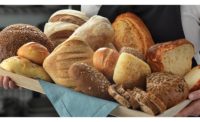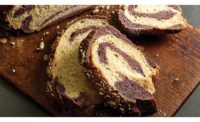As foodie culture grows, the bakery world can expect an increased interest in artisan pursuits and a renewed excitement around heirloom grains and specialized grain-seed blends in baking. Combining grains and seeds into unique, proprietary blends can create high-impact flavor, distinct texture, nutritional advantages and visual appeal.
Aesthetics. As an artisan baker, I Iook at different blends of seeds or grains and consider desired usages and results. One of my first considerations is how custom blends will make the outside of bread loaves or other baked goods look. People eat and buy food with their eyes, and there’s no better way to increase bread’s eye appeal and unique qualities than to use flakes and chopped grains to bring out the aesthetics of bread loaves.
Bakers might choose their grain and grain blends depending on the type of baked good they’re making. Whether making a classic wheat French baguette, marbled rye or dark pumpernickel, it’s important to think of contrasting colors. For example, barleys come in several colors, and when roasted, their colors deepen and their flavors intensify. I like to try different color barleys in swirled or marbled breads.
Flavor. Grain enrobing can also give an indication of what’s inside the loaf, which leads me to my second consideration when choosing grains: flavor. Custom grain blends can greatly enhance the flavor of bread. For example: Teff has a strong, earthy flavor; amaranth has some peppery notes; and sorghum has a slightly sweet flavor. I encourage bakers to experiment with different grains and grain combinations to get the desired flavor profile. When freshly toasted in the oven, grain and seed flavors become more pronounced, taking on more roasted or nutty flavors that contribute a big plus to artisan baking.
Another consideration for selecting grains is to learn how these grains affect your crumb. Bakers can add different grains to add particulates to the bread. When working with different grains and wheats, it is important to make sure they’re properly hydrated and that you don’t overmix them. The blends can be presoaked to keep the crumb from drying out.
Nutrition. Bakers should also consider the nutritional profile they want to achieve and how grain mixes can help meet those goals. More consumers are taking individualized approaches to their diets. Bakers can choose ingredients for higher protein, more fiber and/or less gluten, as well as ingredients that bring increased energy and satiety. In terms of whole grains, we’re seeing more interest in high-fiber sources, like barley flakes. I make a bread using high-fiber barley flour with barley flakes and chopped kernels for topping or enrobing. When you put all three ingredients together in a barley pumpernickel bread with honey and molasses, you get a delicious bread with a higher fiber content than traditional bread.
Barley can be used in conjunction with other grains like oats and rye to create breads or rolls that are lower on the glycemic index. I recommend using cracked, flaked and/or rolled versions of grains to create different textures and eye appeal while also enhancing nutrition. Bakers are experimenting with these heirloom wheats to learn more about their effects on digestion and gluten tolerance.
Better mixes. Often, bakers feel restricted, because they don’t have storage capacity or the volume to buy a significant amount of grains separately. Many artisan bakers purchase their own grains and mix them by hand, which can lead to inconsistencies. I encourage bakeries large and small to work with mix facilities that can supply premixed grains and can also work with bakers to create customized blends of grains.
Going forward, buying and using blends will become easier and more convenient for more bakers. Mixing different grains and forms of grains together allows bakers to use simple, clean, identifiable ingredients, make multigrain claims, enhance nutritional profiles, increase fiber and create unique and delicious baked goods.




